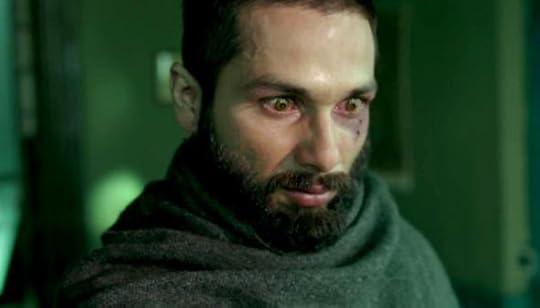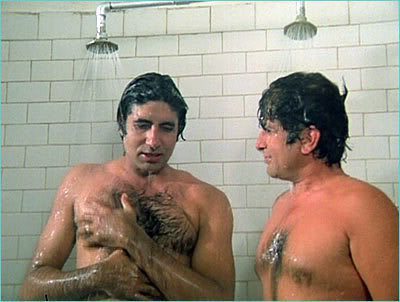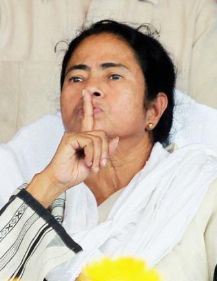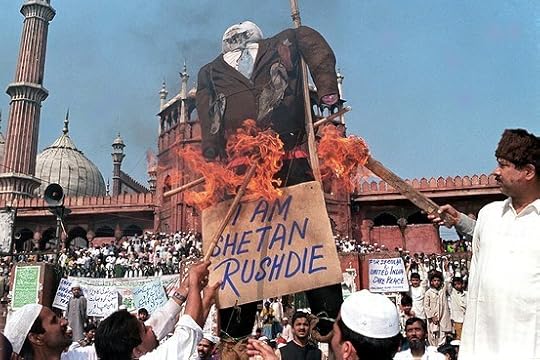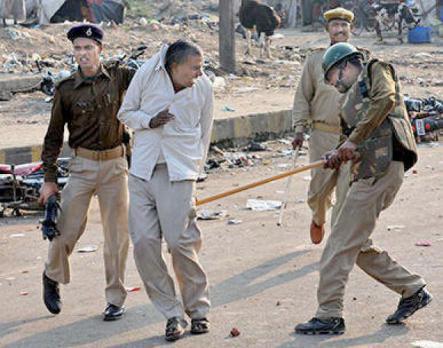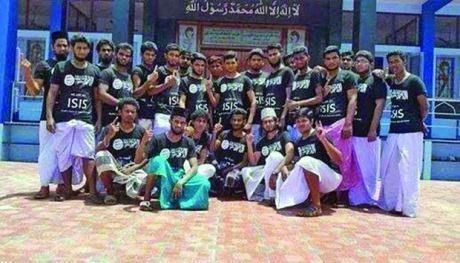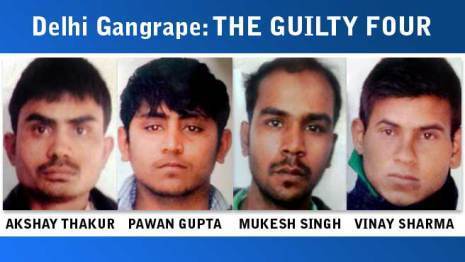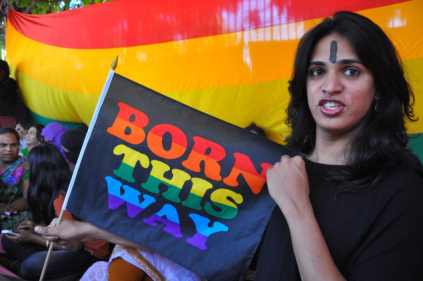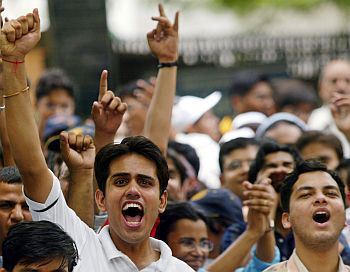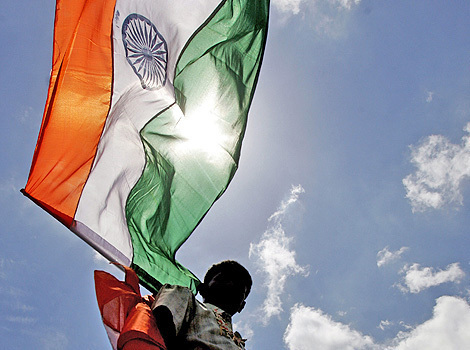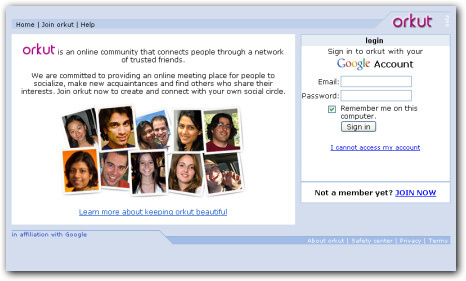Arnab Ray's Blog, page 18
October 12, 2014
Few Thoughts on Haider
I, like many others of my generation, grew up on an oily diet of Kashmir masala films.
Roja. Which, besides introducing this guy called A R Rahman, gave hope to boys like me that you could have a physique like ArvindSwamy but still get to curl your fingers around the shapely waist of a Madhu, if you play the marriage cards right or if the script-writer writes that in the script for you.
Pukaar. Where sinister plots from across the border are spoiled by Anil Kapoor’s verdant chest hair.
Mission Kashmir. A convicted Bombay Blast accused played a patriotic cop and where the man who single-handedly wiped out polio played a terrorist.
Countless other action films, their names a-blur, typically starring Sunny Deol, in which all laws of physics and common sense could be violated as long as Pakistani ass was being mausichi-ed.
The rhetoric was simple. Pakistan was evil, India was good, Kashmiris were misguided and all would be well in the end if the pesky Pakistanis and their agents were demolished.
When I came out of the theater after seeing Haider, I was happy I had seen a film that had flipped the formula. I was happy that finally the censors were letting audiences decide what was wrong and what was right and that there were no bans or stay-orders or any of the other silliness that has so stifled the free expression of ideas in India, a fact that was doubly surprising given that our wise mediwallahs had been prophesying a dystopian Hitlerian Bharat of suppress-oppress-depress ever since that man took over.
Haider is a film that deserves to be seen. It is about as ingenious an adaptation of Hamlet that you could hope to see, true to form and structure and with enough “A-ha that was nicely done” moments which make it more than worth the price of admission. Tabu is sensational, the cinematography marvelous, and Shahid Kapoor abandons his “saaj daaj ke tashan mein rahena” mainstream leading man avatar for something different, the kind of risk most of his contemporaries would not even consider taking. Haider is not perfect of course, with Shraddha Kapoor recycling her Aarohi expressions, the Rosencratz-Guildenstern Salmaniacs hammy in a Keshto Mukherjee comedy track kind of way, and the politics of the film suffocating the narrative at several places. But even then it is pretty darn impressive, particularly in an age where people like me who love cinema have given up on Bollywood producing anything except 100-plus-crore targeted products of the Bang-Bang variety.
The pity though is that Haider is just as black and white as anything Sunny Deol would have put his name to, as jingoistic in its propaganda and as selective in its portrayal of reality as its less pretentious cousins.
To be honest, any time you name your villain as Abhrush as Pukaar does or the director’s credit says Guddu Dhanoa, you are not expecting the audience to take you seriously.
However Haider wants you to trust that it is painting the real picture of Kashmir, anchoring the story to actual incidents and making the film realistic and gritty, and then for good measure, harping on the “this is the true story of Kashmir” angle in the movie promotions.
This is definitely not fiction, in the way Mission Kashmir is, and it would be naive to argue otherwise.
It is pointed political propaganda.
And that’s where it goes wrong for me.
Haider starts off with the honest, upright doctor, with the sad gentle face, who also own ponderous books titled Physics in his library (alert: intellectual), being called by “independence fighters” to take out the infected appendix of its leader. Now being a dutiful doctor, he not only treats his patient, a criminal as per the laws of the Indian state, but extends the scope of the Hippocrates oath to also hide him in his emergency vehicle and bring him home. Now in some places, this might be defined as “harboring a criminal and aiding and abetting crimes against the state” but in the world of “Haider”, this is positively heroic, because of course the Indian state is the criminal and this person is a freedom fighter. The Indian Army comes, the doctor comes out holding his passport where he is identified by a masked traitor sitting in the car (There is a gigantic plot-hole here, given the resolution, but I am not getting into that, trying to keep this as spoiler-free as possible). The Indian Army goes into his house where they are fired on by the Azaadi-fighters with AK47s. Taking losses, the commanding officer decides to mortar down the house because he does not want to risk the lives of any more of his officers.
In some other film, this might seem to be the rational decision given that there are terrorists armed to the teeth firing back from the house.
But Haider is no “some other film”. Here it’s all symbolic. Tabu is the state of Kashmir, Shahid Kapoor the conscience, and Kay Kay Menon…well watch it to see what he is. And that broken down house is symbolic of the cruelty of the Indian state, as we are shown how Haider, the son of the doctor, mopes about its ruins, remembering days gone by.
Bharadwaj is pulling the heartstrings here and there is no doubt where your sympathies are supposed to lie.
And so it goes, Haider alternating between story and blunt political sloganeering.
There is nothing new about the version of events of course, this is the official azaadi narrative.
The Kashmiri-fighters are innocent lambs who only fire when fired upon, the real terrorists are the Ikhwan-ul-Muslemoons, agents of the Indian army tasked with extrajudicial killings of the Azaadi-fighters, Kashmir is a big open-air prison for its denizens, and the Armed Forces Special Powers Act is the worst instrument of India’s aggression.
As I said, nothing new.
However even more important than what Haider keeps in is what it keeps out.
While there are anti-India graffiti scribbled everywhere on the walls, there are no green flags of Islam (not any I saw), no Islamic slogans, no “Kashmiri Hindu men leave Kashmir but leave your wives and daughters” naarebaazi, or any kind of religious symbolism that characterizes the radical-Islamic nature of the Kashmir struggle. In each frame, Bharadwaj drains out the radical green and colors the struggle with the neutral black color of secular suffering and “azaadi”. This de-religionization of the most radical agitations is the intellectual subterfuge that allows self-avowed Leftists to throw their lot in with Islamic-fundamentalist power-grabs all over the world, despite inconvenient developments like the underdog-against-evil-overlord Syrian independence struggle morphing into ISIS, and allows them to frame the battle in Kashmir as one waged by an evil expansionist state against innocent citizens, and not one of a secular nation protecting itself from Talibanization/ISIS-ization.
Moving on.
A standard author-trick is to make an evil character say a number of statements. Once you discredit a large number of those statements later on in the narrative, the ones you don’t discredit explicitly become false by association.
Bharadwaj does this in Haider. Here is how.
Ashish Vidyarthi plays an Indian Army commander who, in a press conference, expounds on the policy of using terrorists to kill terrorists, or as it is known technically “Jaise lohe lohe ko kaatta hai” from the film Sholay, historically a strategy used to break the Naxals in Bengal and Khalistanis in Punjab. Since those familiar with the history of the state know this to be true, it is obvious that we are not in the realm of total fiction, we are talking “what actually happened” now. Ashish Vidyarthi then says that the Indian Army does not torture, it interrogates. The movie then demolishes that “lie”, showing multiple instances of inhuman torture on supposedly innocent Kashmiri folk. (As a matter of fact, the original torture sequences were more graphic it seems).
Then Vidyarthi says that the freedom struggle is an expansionist design of Pakistan. That the movie wants us to believe is the second “Indian lie”. In a subsequent plot point, another treacherous Indian agent calls Person X a Pakistani ISI agent, and since this treacherous Indian agent only lies and the said person is not shown to be a Pakistani, there we have another falsehood.
Two lies. Now comes the third statement.
The Kashmiri Pandit exodus. Vidyarthi throws it out there, and by association, that becomes the third “Indian lie”. Once again, this is very much part of the Kashmiri-struggle narrative, the fact that the exodus of the Kashmiri Pandits is either false or grossly exaggerated or entirely voluntary, and that the mention of Kashmiri Pandits in any conversation on Kashmir is done with the express intent of discrediting the noble Azaadi fighters and bringing a kind of moral equivalence between them and the “Indians”. Of course the fig-leaf used by the makers of the movie would be that it is to give the other side of the story, but that is absolute tommyrot, given that it comes from the mouth of the villain whose every other statement is a lie, and most importantly because, the film never once tries to tell the other side of the story in any serious way(and yes the closing dedication to the Army was so egregiously “for the censors” to be almost laugh out loud funny, like porn films that end with the message “Porn is bad”)
Again a film does not require balance, it can be as tunnel-visioned and as one-sided as it likes. It just needs to work as a film. Haider does. Most definitely.
But to sell it as the true story of the Kashmiri struggle requires some…what’s the word now?
Chutzpah.


September 22, 2014
Events for Yatrik
1. September 24, 6: 30 pm, Crossword Kemps Corner, Mumbai
2. September 25, 6 :30 pm, Crossword Sarakki Industrial Area, 15th Cross Road, J P Nagar, Bangalore


September 17, 2014
Bad Culture
[originally published in Du-kool]
There was a time many years ago – I think I was in class 6 or was it 7 – that my mother thought that it would be a good idea to make her son into an outdoor type of person. So I was sent off to a one week nature-study-camp in the forests of Orissa. There I learned how to tie knots, identify constellations in the sky, and the proper steps that must be taken when your torch falls into the communal toilet at two on a moonless night. This camp, which as you can see I enjoyed a lot, used to have a daily event, the campfire where camp attendees were encouraged to perform. You could recite poems, do skits, tell a story, or you could sing.
One rule however.
No Hindi film songs.
Actually no Bengali film songs either, except songs from Satyajit Ray films, which were of course okay, because, Satyajit Ray.
In Bengali, “apasanskriti” is a four-letter word, whose most appropriate translation to English, would be “bad culture”. A Bengali might forgive bad behavior or bad breath, but never bad culture. And film songs, both Hindi as well as Bengali, were considered to belong squarely in the middle of the “bad culture” Venn Diagram (which, to Bengalis should actually Benn Diagram because we have no “V”).
So what was good culture? Rabindrasangeet. For variety, there was Najrul-geeti, Dwijendralal Roy songs, and of course, songs of red-hot patriotism. But mostly Rabindransangeet. I grew up in the middle of Rabindrasangeet, the buttery Subinoy Ray, the robustly muscular Shantidev Ghosh, the mellifluous Suchitra Mitra, the innovative Debabrata Biswas, their voices streaming out every few afternoons from the open-reel audio recorder, a possession of the Ray family, as prized as the Telerama Color TV and the EC Black and white that came before it. To this aggressive home diet of Rabindransangeet, was added music class in school, where corpulent aunties closed their eyes, swung their heads to the side, and belted out, “Amar ei deho khani tule dhoro” (“Lift my body in your arms”), accompanied by giggles from the back benches, and if this was not enough, there were generous servings of Rabindrasangeet on TV and on radio and everywhere I went.
I rebelled. I mean, I could have left home and driven cross-country on a bike, and started a revolution. But I didn’t.
I embraced Hindi film music.
Not that I did not like Rabindrasangeet. Balmiki Pratibha, Rabindranath Tagore’s dance-drama on the origin story of Valmiki with its rather peppy tunes – I could sing it all from memory.
But it happened that as the years went on, I went deeper and deeper into my own personal anti-intellectual revolution.
I would stand at the very corner of our third-floor verandah listening to “I am a disco dancer”, or “Kasam paida kadne waale ki”, playing on a loudspeaker from the nearby slums, my foot tapping to the rhythm. One could not sing Hindi film songs at school. Which meant I just had to. “Oye Oye” was bad culture. So I hummed it. So was “Ek Do Teen”. I hummed that too. Soon I was participating in college-level Hindi film antaksharis, and as I came to the US to study, was conducting my own. Some of my friends were into metal and other “foreign” stuff, and I loved my Michael Jackson and my Madonna and my George Michael, and even Cyndie Lauper (yes, scoff and judge me as much as you want), but that was where I stopped my Western influences. It lacked the melody I craved.
Hindi film music stayed my only love, even when the rebellious impulses had died away by time. Soon my parents, Hindi film music skeptics, were sitting with me, watching Superhit Muqabla, the first Hindi film music countdown show on TV. Not that they always liked what they saw, outraging, like everyone else, over double-meaning lyrics and provocative dance-steps and the effect of these on the moral health of impressionable children like their son, but they still gamely hung on, connecting to their teenage son in the language he understood and also, I suppose, keeping a careful eye on what he was consuming.
And now I am pushing my late thirties. I appreciate Rabindrasangeet once again, being old enough to understand the concepts of love, devotion, mortality, nature in a far deeper way than I was when I was ten, when I had to nod along to whatever my parents said was good.
I also find myself outraging much. I am concerned about the misogyny of Honey Singh, mortified by the expanse of cleavage in “Blue Hai Paani Paani”, and extremely distraught by the Hindi-Bangla-English hybrid lyrics that seem to have become de rigueur for Bangla film songs (“Challenge nibi na sala, panga nibi na sala” and “ Majnoo-ta boroi deewana”).
A few days ago, my wife and I were sitting in the living room of my Maryland apartment, with my eighteen-month-old running around, watching Hindi movie songs on an Indian channel. A song from my childhood (Sridevi’s famously sensual “Kaate naheen katte din yeh raat”) came on. As the heroine writhed suggestively in her gossamer sari, my wife told me to change the channel. I looked at my wife, and said “Aww please, this is exactly what our parents used to say. I mean, this is nothing compared to what goes on today”. Then I paused for a few seconds, realized that she was right, felt uncomfortable, and changed the channel to that other music that I enjoy watching nowadays, Arnab Goswami on Times Now shouting down all, and sundry.
Which is when I came to the realization that while the music hadn’t changed, I had.
And there will be a rebellion coming in my own house within a few years, and new beats and new rhythms and new lyrics, while I shout “No you cannot. That’s bad culture”.
I can barely wait.


September 8, 2014
Leaked Table of Contents
Leaked table of content of book “2014 The Election That Changed India”
Forward by Ms. Ghose: How the Internet Hindus Became The Nazi Stormtroopers of Modi And Some Other Ruminations On My General Awesomeness.
1. Morning Maalish: The Relationship Between The Media And Congress Before Modi
2. Where I Put Tough Questions To Modi
3. Blow To Modi
4. Yet Another Blow To Modi
5. Truffault’s 400 Blows To Modi
6. CNN IBN Sweeps All Awards at CNN IBN Awards.
7. Old Monk With Vinod Mehta
8. Ten Secular Tips For Every Newsroom
9. The Inconvenient Sting Operation: When Things Don’t Go As Planned
10. The Anna Experiment: Propping Up the B Team Part 1
11. The Nitish Kumar Experiment: Propping Up the B team Part 2
12. Krantikaari Hyping The AAP Revolution: Propping Up the B Team Part 3
13. Modi Is Hitler
14. I Hate Modi
15. Did I Tell You Modi Is Hitler?
16. That Other Rival Channel Or How I Let My Guests Finish Their Sentence
17. Predicting The Elections, Lessons In Wishful Thinking
18. Science Fiction Writing and Alternate Universes
19. How Modi Narrowly Beat the Congress: The Real Numbers Behind the Elections.
20. How The Hindu Right Gamed The Number System Through Vedic Mathematics And Stole The Elections
21. How The Media Lost Its Moral Compass And Cheerled Modi
22. Using LPS: Liberal Positioning System Always Helps Me Find My Way
23. Thoughts On Media Independence: Standing Up Those In Power
24. I Got My Padmasree From Those In Power. Hell Yeah !
25. Rahul Gandhi: The Second Most Misunderstood Man in India (The Most is Me)
26. Why I Am The Greatest Journalist Ever
27. Top 5000 Praise Tweets That I RT-ed.
28. Lata vs Asha
29. G’ Nite.
[Disclaimer: This is a spoof. ]


August 20, 2014
Ice Bucket Challenge
The first time I heard about the “Ice Bucket Challenge” was when a video of Satya Nadella, the Great Indian Whose Achievement We Have Appropriated, showed up on my Facebook News Feed. I first thought seniors from college who had missed ragging him had finally managed to catch hold of Nadella or perhaps the people who had paid for Windows ME had. Anyways I soon found out that this so-called ice bucket challenge was the new viral sensation, the Macarena of 2014, though I am still not sure if dunking yourself with ice gets you out of a contribution to ALS (the Wikipedia entry seems to suggest so and so does Charlie Sheen’s video) or that you are supposed to do both. Anyways, it is a most worthy cause, millions of dollars have been raised and everyone from Justin Bieber to Sonakshi Sinha have done it but not Modi and there, Arnab Goswami and Caravan magazine and Kafila, you have an idea for your latest outrage.
This post is though isn’t about the ice bucket challenge per se. It is about icy baths in Hindi films, the mechanics and the implications.
Which means I have to start with the original “Ice Ice Baby” song, namely “Thande thande paani mein nahana chahiye”.
It was an age when leading men did not need rock-hard abs and rippling muscles to impress audiences or, for that matter, to make a play for Hema Malini.
I am of course talking about Sanjeev Kumar, who only lost weight when Gabbar Singh cut off his hands.
But his high-fat content did not prevent him from getting shirtless and extolling the act of bathing in ice-cold water, despite what cold water reportedly does to men.
Not to him of course because as the song goes on he walks up and grabs Vidhya Sinha and makes her wet or I should clarify, in the words of the song, he makes her sari wet.
But in all this song of ice and fire, and chilly drenchings, the most seminal (and I use the word intentionally) remains “Aa Gale Lag Jaa”. No this is not the movie with the two heroines, Urmila Matondkar and Jugal Hansraj, but the one with Shashi Kapoor and Sharmila Tagore. Shashi Kapoor, unlike his elder brothers, never really had a great solo career, despite the good looks and the talent, with his biggest successes inevitably coming in double-bills with this guy whose wife wants to ban jokes on MPs.
“Aa Gale Lag Jaa” was one of his modest hits and it had the most innovative ice bucket challenge-type plot device ever.
Let me go through it in some detail.
Shashi Kapoor meets and falls in love with Sharmila Tagore during a figure-skating competition. There they flirt with each other to the tune of “Wada Karo Naheen Chodoge Tum Mera Saath”, which when you read it carelessly, does seem to mean something else. Anyways after the competition is over, Sharmila Tagore asks Shashi Kapoor out on a date. But not to a coffee shop or for a movie. No. She asks him if he can come and volunteer for a medical experiment that is to be conducted. Now if Shashi Kapoor was thinking about anything other than Sharmila Thakur’s bare midriff, he would have thought “Hmmm…maybe she wants to steal my organs”. But so besotted with her is he that he says Yes. So he comes to this medical college where he is made to strip and lie down on blocks of ice. Even then he does not consider the possibility that they are planning to harvest his organs. Such is love.
Apparently this is a slightly off-normal medical school , possibly inspired by Dr. Mengele, where if they want to teach students hypothermia, they make a man lie on blocks of ice and develop the symptoms. One by one the comely doctors (all women, take that diversity) take his vitals—pulse (60), temperature (90) and then Sharmila Tagore takes his blood pressure, which is one number (68), since obviously his systolic and diastolic blood pressures are the same and equal love. The doctor asks what should be done to him. Tagore blubbers some medical gobbledygook after which the doctor tells the assembled doctors that, when no medicine is present, the only way to save a man dying for hypothermia is “jismani garam” (body heat). It does not take much for the smart doctors to cotton on to the fact that he means the honky tonk and for those too dumb to get it, the doctor mounts Shashi Kapoor, and is about to do a kinky maneuver when Shashi Kapoor, a gentleman to the core, wonders if it would be better if one of the other doctors did this part of the demonstration.
Needless to say, this is all a set-up for what is to follow.
Sharmila Tagore falls into a ice-cold pool of water while dancing with Shashi Kapoor in the mountains. Shashi Kapoor takes her to a cabin and tries his sincere best to increase her body heat . He rubs the soles of feet. He tries to start a fire. But nothing seems to work till he remembers the medical lesson. With infinite reluctance on his face, reminiscent of the expression Rohit Sharma gives when he is dismissed (which is often and soon), he turns Sharmila Tagore to the side, removes something at her back, which is censorspeak for “undress” and then uses his jismani garam. And as per The Law of Roop Tera Mastana, if you are holed up in a deserted cabin with a character played by Sharmila Tagore and happen to catch a glimpse of her bare shoulders, the probability of you getting her pregnant is one.
And so she gets knocked up and the challenges begin. All because of an unintentional ice-bucket challenge.
Fast forward fifteen years. The Big B is in a mid-life crisis, too old to be the angry young man and still too young to realize that a bright future lies in the future as a quizmaster, brand ambassador of Zoom Money Transfer with Locked in Exchange Rates Jhatajhata fatafat, and actor of age-appropriate roles. He had signed on to this movie with the rather Neil Nitin Mukesh name “Ganga Jamuma Saraswati” which just happened to be directed by the same man who had made Aa Gale Lag Ja (Manmohan Desai).
Ganga Jamuna Saraswati had many demented situations, none perhaps as demented as a the notion of a duet sung by Kishore Kumar and Pankaj Udhas with music by Anu Malik. One of these set-pieces was the ice-bucket challenge thing once again. Meenakshi Sheshadri it is now who falls into the frozen lake (unrelated factoid: gossip magazines used to refer to her as the “Ice Maiden”) and Amitabh Bachchan is forced by circumstances of course, the exact same circumstances that had plagued Shashi Kapoor all these years, to cojoin with the freezing girl. What’s truly amazing is that Amitabh does the same set of actions that Shashi did, almost in the exact same order, including turning Sheshadri to the side and unclasping one button (the very same), and then making the same anguished expression of martyrdom. The result is also exactly the same. Meenakshi Shesadri gets with child, another series of complications ensue that culminates in Amrish Puri getting his bald head chewed off by a crocodile.
How did Amitabh Bachchan know exactly what to do, given that he never heard that lecture in the doctor training college?
But of course.
Which finally brings me to the point. While the ice bucket challenge might now have come to mean ALS awareness, in my days it had another connotation, almost as altruistic.
It meant heroic copulation, where the act is motivated not by lust but by supreme self-less duty.
Or as the kids call it nowadays, married-couple sex.
And now that I have made that joke, I shall take a cold shower.


August 19, 2014
Ten Years Of The Blog
Time flies when you are having fun. Or when you are having pitched battles on comment threads.
On August 20, 2014, this blog turns ten
I never thought I would be saying this, when ten years ago, on a cold Detroit evening, all alone at my first job, away from the comforting shelter of graduate life, I had started typing into the dark. I had never thought there would lie in the future, book deals, writing opportunities in places I could never dream of writing for, and many many great friends. There is a life lesson here, something about taking that first step and not holding back, but I will save the details for a TEDx talk.
So thank you. Thank you everyone. Thank you, the Himesh worshippers, the “SRK is god” olytes, the ipod-wanters, the Internet Hindus, the sickulars, the haters, the Gunda cultists. Thank you, Luck, for giving me an audience. Thank you Wife for giving me the time. Thank you Life for keeping me alive.
Far more deserving have not been so privileged.
In celebration of these ten years, I have compiled a list of ten posts. Ten posts that capture the essence of this blog. The selection algorithm was the exact same as the one used to rank Indian engineering colleges in popular magazines.
That is, there was none.
So in no order, except that of randomness (for isn’t that what this blog is all about), I give you:
1. Hottie Hottie Bong Bong: The first of my posts that got some attention, this is me writing on one of the toughest subjects in the world, namely Bengali women. I have written about Bongness in general subsequently (and I prefer this piece personally in terms of the writing) but the first one always has the charm.
2. Mithunism the religion: The post that made the blog.
3. Gunda: Gunda and Kanti Shah have gone onto become cult. I would like to think this post contributed a wee bit to that. Something that I should say here that I have wanted for a long time. This post is not *really* about Gunda. It’s a critique of criticism (cinematic as well as literary). How? I will explain when the blog turns twenty.
4. Boy Prince: I love writing stories. I love writing about politics. Sometimes I do both together. (This post had a sequel too)
5. The Day We Won The Cup: Reminiscences of 1983. Thoda sentimental. For a more mordant read, allow me to recommend Walking With The Men In Blue which is my take on how Arundhati Roy would have written on the 2011 World Cup triumph.
6. The Great Wall Street Meltdown: Multi-part series on the Wall Street Meltdown. One of the greatest compliments I received was someone saying that he ace-ed a GD solely based on this 3 part series. I realize he may have been exaggerating but still…
7. Kaho Na Massacre Hain: A few days ago, I had written a post with pictures and single lines. Someone on Twitter said something on the lines of “Inspired by Buzzfeed?” (twitterspeak for: so desperate you are copying Buzzfeed style). The post linked here was written in 2006. This was before Buzzfeed was popular. So the answer is “No”.
8. A Letter From Andaman Cellular Jail: The people who brought you freedom. People like my grandfather.
9. The Killing Fields of Nandigram: I have written serious political posts many-a-time on this blog, (including recent multi-part deconstructions of Modi and Kejriwal) but none of them got 667 comments. On one single post. Around 2007, I had written a number of posts where I had prophesied the kind of government Mamata Banerjee would lead (captured succinctly here in this post on the death of Jyoti Basu) and now that I have been proven right, allow me my moment of “I told you so”
10. I am going to cheat here. Your favorite RTDM post. That’s the tenth.
Is there anything else I have to say?
Of course there is.
I may have tweeted this many times before but I realize I have not mentioned this on my blog.
My third novel “Yatrik” comes out September. Here is the cover, an endorsement, the blurb and a link to first few chapters of the book.
Please do buy the book. And do keep coming back to the blog.
Till the next ten.
Arnab Ray’s novel Yatrik is a fascinating, fast paced read about looking back at life from the threshold of death, at secrets that surprise us. The novel mixes realism and the fantastic superbly, and gives us characters that we learn to love in spite of their flaws.
- Chitra Divakaruni, author of Oleander Girl and Palace of Illusions
Jacket Blurb
‘Anushtup Chatterjee, I am really sorry to have to tell you this. But you have died.’
Anushtup Chatterjee is thirty-two years old.
He hates his mother. His job is a dead end. And his girlfriend has left him.
Then one silent moonlit night, he wakes up in a deserted field in the middle of nowhere, with no recollection of where he is or how he got there. His wallet is gone. So is his cell phone.
He is not alone though.
There is another man there, a stranger with a gentle voice and a humble mustache, who has something rather unbelievable to say to him.
That he, Anushtup Chatterjee, has already died.
Mysterious and achingly poignant, Arnab Ray’s Yatrik is a story about hope and aspiration, love and regret, of the choices we make and those that life makes for us.
First two chapters of “Yatrik”
Releasing on Kindle and in print September 2014.


August 14, 2014
I Want The Freedom To
I want the freedom to draw cartoons
I want the freedom to make jokes
I want the freedom to be not harassed
I want the freedom to read
I want the freedom to be equal
I want the freedom to be not afraid
I want the freedom to live
I want the freedom to walk

I want the freedom to be born a woman
I want the freedom to love
I want the freedom to hope
I want the freedom to be…me
[Images courtesy Rediff, IBN, Hindustan Times, WSJ, Frontline]


August 12, 2014
The Sadness of the Comic
If one ever wanted to make a movie about a superstar with a flair for characters and for physical comedy who ends up dying of depression while making the world laugh, there would be no better man to play him than Robbin Williams. And so it came to be, art became life or was it the other way round, and the sad irony of the whole thing would definitely have made Robin Williams himself laugh.
It’s difficult to make laugh, difficult even more to make people laugh so much that they cry, and difficult most to make people cry while they laugh. In that Robin Williams was a master, like Charlie Chaplin, for their best performances, always had a melancholic poignancy to them, lingering long after the laughter had died down.
Think “City Lights” and the last scene where the girl who can see again sees the Tramp finally for who he is. Think “Circus” and the Tramp standing lonely and forlorn, the circus caravan having left and with it everything he has ever loved. Think “Limelight”.
And then think of “Dead Poet’s Society” and “Good Morning Vietnam” and “Jakob the Liar” and the Genie finally becoming free of the lamp in Aladdin. Even his greatest commercial success, Mrs. Doubtfire, which is about as crowd-pleasing a physical comedy as you are likely to get, has a bitter-sweet resolution that elevates it above the mere run-of-the-mill. Be it as a brilliant doctor trying to cure an incurable disease (“Awakenings”) or as a photo-processing clerk for whom pictures are the only windows into happiness that he will ever have (“One Hour Photo”) or a deeply-damaged psychiatrist coping with the loss of his wife and child-abuse (“Goodwill Hunting”) , Williams would bring this deep sadness and empathy to his characters, like few of his contemporaries could.
As a matter of fact, once you go down the list of his films, you are amazed to see how many characters he played that were morbidly lonely. Maybe his skill at playing loners came from something deep inside him, something that was him. Maybe funny people, are by nature, melancholic, their funniness a defense mechanism against the world outside.
For the line between happy and sad is as blurred as that between life and death.
Goodbye Robin Williams.


July 28, 2014
Story Board For Most Outrageous Ad Ever

So here is the storyboard for the most “guaranteed to outrage on Twitter” ad ever.
—–*—–
Wife is lathering fairness cream on her face.
Internal monologue “Hope he won’t abandon me like my last husband”. [Shot of her in bridal jewelry standing with a glass of milk and a tube of vaginal tightening cream, while a man walks out, sprays Deo and drives away on a bike]
Cut to present.
Voice of current husband (Husband off-camera): “Khana kahaan hai? Is bar bhi kya khana mujhe 3G pe dekhna padega?”
She says “Ayeee”.
Just then her husband’s phone rings to the tune of Honey Singh, and she sees a missed call from a woman with a Sania Mirza picture.
She picks up the phone. Flips through texts sent by woman.
Quick montage of texts.
“You pseudo-sexular naughty man.”
“Come baby. I am feeling so communal tonight.”
“I have lost my moral compass“
Camera focuses on woman’s face. Tears stream down.
Right then, husband pops his head in, holding his wife’s phone.
Trembling with rage he asks, “Who is Sachin Tendulkar?“
Tag Line: Shah Bugging Systems. Tomorrow’s secrets today.


July 12, 2014
Goodbye Yahoo ! Chat. Goodbye Orkut.
Once upon a time, there was no high-speed Internet, the mention of the word apple still conjured up images of a fruit, the forward-thinking Xerox-“STD” stores charged one rate for domestic email and another for international email, Pagerank was still in “What the eff is that?” phase, intellectuals did not have the luxury of appearing erudite by reading Wikipedia just-in-time-for-an-argument, and research was still done in libraries—you know the ones where they keep hard-copy ebooks.
And Yahoo! was Salman Khan, the 100-crore giant in the room. It was your browser home-page, the post-box where you got your email (there were so few that you even read the spam) and the search box where you typed in “Cindy Crawford sexy pictures”. Sure, some people used Hotmail too, perhaps under the mistaken impression that the mail you would get there would be of the hot type, but still Yahoo ! was the most popular online destination. It was whispered that the people behind Yahoo! were Shammi Kapoor fans, but since there was no Wikipedia then, we could never confirm if this was true. But we assumed it was.
It was around this time that many started discovering this other Yahoo! feature.
Yahoo Chat. Or simply the ! in Yahoo !
I mean, Desibaba was all well and good, but there is only so much that morphed pictures of Karishma Kapoor and stories of the “Bhabhi ki kharabi” series can do for a hot-blooded individual. One then desired the company of a real person of the opposite gender, and so the thirsty generation waited, till the night fell and parents fell asleep, to fire up their dial-up modems, the whrrrrr hunting tone making them throb with the anticipation of the hunt, as they quietly dove into the world of Yahoo! Chat rooms.
20’s Love. 30s Love. Adult-themed chatrooms that only one’s friends visited.
Clicking on ids, initiating contact(virtual), waiting for replies, and then if Houston made contact, to proceed with the opening move that came to be known as a/s/l (Age/sex/location).
Frequent denizens of Yahoo Chat, and I can only speak from the male perspective, knew the rules. Rule number 2 was that angelgirl123 and bustylusty4u and similarly provocative ids were all bots, who wanted you to click on links. Rule number 3 was that one could use Salman Khan’s picture as your own only when chatting in UK and US rooms. And rule number 1 was that any female-sounding id who initiated chat contact with a male id was either as a bot or a jealous girl-friend under another name trying to validate her man’s honesty or, this was most common, a man. For some reason I could rarely fathom, a large number of men would chat as women in Yahoo ! Perhaps they wanted to experience the sensation of being wanted, a sensation many used to a life of lonely desperation never quite experienced. Perhaps they suffered from the prison syndrome, where you no longer care if it is a man or a woman. Whatever may have been the real reason, the things to remember was that if something was too good to be true, it definitely was. The ultimate confirmation of the gender of the finger at the other end of the chat-line would obviously be a voice chat (and one cultivated an ear to distinguish genuine women from desperate men doing their best Lata Mangeskar impression) and the holy grail, video chat. But with the speed of dial-ups being as they were and that blood was cheaper than megabytes of bandwidth and most importantly women never did cam-chat unless she was speaking to a man with whom she already had two children, the chance of visual affirmation was about as much as that of Venkatapathy Raju winning a Mr. Universe bodybuilding competition.
And hence they all groped along in the darkness. Literally and cyberly.
Yahoo! Chat was not just about making connections in the great beyond. It fuelled the economy, building, together with gaming and porn, the cybercafe business in India. College kids and yes even school kids would come to cybercafes, in groups, and huddle over one Pentium machine, giggling and nudging each other, bags placed strategically on laps. As chat rooms became voice-enabled, communities started to build around Chat rooms, with people fighting for the mic, some singing, some emitting sounds of doubtful provenance, and some shouting random abuse in colorful language for no good reason.
It was organic, it was funny, it was fun, and yes, once in a while, people did find that perfect match.
But then Yahoo!, the company itself began to die under the onslaught of Google. Before we knew it, Yahoo! Chat had become like Sealdah station , not maintained, left to rot and with suspicious people hanging about, looking here and there.
The people had to be somewhere of course. So they began flocking to the next big thing, social networking. The age of anonymity and multiple identities had come to an end, to be replaced by a more conventional interaction ethic that more resembled the real world’s.
Orkut, with its profile pictures and real names, was considered more trustworthy than the wild wild west of Yahoo!, despite the profusion of profiles with Ayesha Takia pictures. Hence it flourished.
A new vocabulary came into being. Friending. Unfriending. Blocking. Scrapping. Testimonials, the politics of which would have overwhelmed even Machiavelli.
With picture albums that were open for public viewing initially, one could spend rainy afternoons surfing through real pictures of women, and then, send them scraps asking for “fransip” with the goal being to evolve the “fransip” into “labhsip”. Sure the English was bad, and ppl missed vowels and used caps and small letters indiscriminately, and neologisms like “hottings” and “nottings” (the latter being considered a portmanteau of “naughty things”) were indiscriminately coined, but one could not mistake the genuine bonhomie and desire to connect across boundaries of space and time, and no where was this better expressed than in the albums of pretty women who would wake up in the morning to find scraps left by total strangers of the type “Nice lag. Will u mekk fransip wid me?”
But then somewhere down the line, Facebook opened itself to the world, with its better user interface and its locked down albums. People started fleeing Orkut faster than industries from Bengal, and Orkut, once dutifully maintained and updated, became like a ghost post-apocalyptic cityscape, there and yet not there,
Not that Orkut could not have been saved. Not that Yahoo! Chat could not have been saved. It was that its owners never figured out how to commercialize them.
The golden age of the Net was now officially over. Things no longer existed for the sheer pleasure of being there. Power had passed from the hands of engineers and scientists and intellectual adventurers to the MBA types. Yahoo! Chat was too anonymous to monetize through targeted advertisements. Orkut was better in that respect but it had not been designed from the beginning keeping in mind a commercial strategy, and the cost of re-architecting it was considered too prohibitive.
So Google built the Orkut replacement Google+, the Rohit Sharma of social networks, supposedly very awesome but no one knows what its good for. Facebook though won as the social network war, evil and omnipresent, monitoring and mining every thing you do. What used to be innocent questions like “What are you wearing?” during Yahoo! Chat days are now commerce-driven information processing queries, with Facebook knowing not only what you are wearing now but also what you will wear tomorrow, and here is an advertisement for you from one of our partners to stock up your wardrobe, and even after you leave Facebook, they pursue you in your other tabs, like a won’t-take-no-for-an-answer pimp.
So today we pine. Today we weep. For Yahoo! Chat and Orkut no doubt, but more than them, for those kinder, simpler times, when corporations did not know what we got off to, when people were users, and not assets that drive stock valuations.
And so it will come to pass. The servers will be redeployed. The landing page will become a static headstone. The lights will be turned off for good.
Yet the two shall remain, in our memories, in hours of lost productivity, in seconds of strategic screen-minimizations,in floating scraps of conversations and in shards of indescribable delight.
Goodbye old friends. Sail gently into the night.



